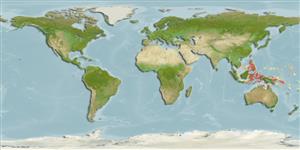Actinopterygii (ray-finned fishes) >
Perciformes (Perch-likes) >
Tripterygiidae (Triplefin blennies) > Tripterygiinae
Etymology: Helcogramma: Greek, helkos, -eos, -ous = ulcer, sore + Greek, gramma = letter, mark (Ref. 45335); albimacula: The species epithet is a combination of the Latin "albus", meaning white, and "macula", meaning spot. The name refers to the pale spot on the ventral part of the pectoral fin base of preserved specimens and is treated as Noun in apposition.
Environment / Climate / Range
Ecology
Marine; benthopelagic; depth range 0 - 5 m (Ref. 52308). Tropical, preferred ?
Western Pacific.
Size / Weight / Age
Maturity: Lm ? range ? - ? cm
Max length : 4.2 cm TL male/unsexed; (Ref. 90102)
Short description
Morphology | Morphometrics
Dorsal
spines
(total): 16 - 18;
Dorsal
soft rays
(total): 112;
Anal
spines: 1;
Anal
soft rays: 20 - 22;
Vertebrae: 37. A species of Helcogramma (sensu Hansen, 1986) with 2 symphysial mandibular sensory pores, second dorsal fin spines usually XIV (two of 80 specimens with XIII and 11 with XV), third dorsal fin segmented rays 10-11, last ribs on vertebral centrum 10, vertebrae modally 10+27=37, pored lateral line scales modally 19 or 20, nape scales present, males with dusky anal fin, both sexes with distinctive pale (red in life), oblong streak over lowest pectoral fin ray bases, adult males first dorsal elongate, reaching base of fourth to sixth spine of second dorsal fin when depressed (Ref. 52308).
Adults are found at depths of 5 m and shallower, in surge channels and exposed boulders (Ref. 90102). Eggs are hemispherical and covered with numerous sticky threads that anchor them in the algae on the nesting sites (Ref. 240). Larvae are planktonic which occur primarily in shallow, nearshore waters (Ref. 94114). Minimum depth from Ref. 58018.
Life cycle and mating behavior
Maturity | Reproduction | Spawning | Eggs | Fecundity | Larvae
Williams, J.T. and J.C. Howe, 2003. Seven new species of the triplefin fish genus Helcogramma (Tripterygiidae) from the Indo-Pacific. J. Ichthyol. Aqua. Biol. 7(4):151-176. (Ref. 52308)
IUCN Red List Status (Ref. 115185)
CITES (Ref. 94142)
Not Evaluated
Threat to humans
Harmless
Human uses
More information
Age/SizeGrowthLength-weightLength-lengthLength-frequenciesMorphometricsMorphologyLarvaeLarval dynamicsRecruitmentAbundance
ReferencesAquacultureAquaculture profileStrainsGeneticsAllele frequenciesHeritabilityDiseasesProcessingMass conversion
Tools
Special reports
Download XML
Internet sources
